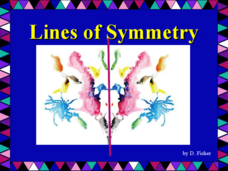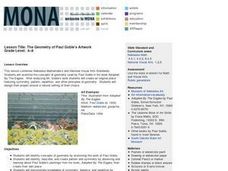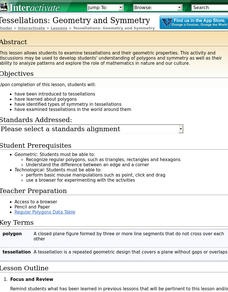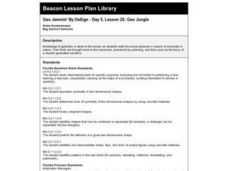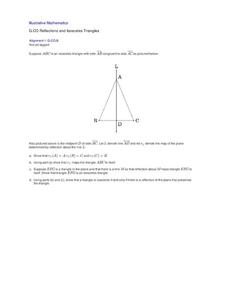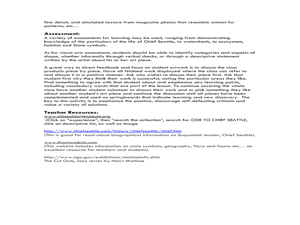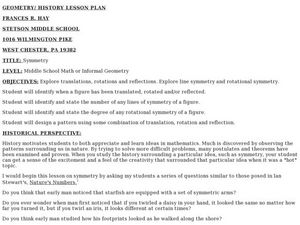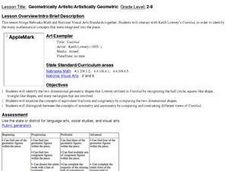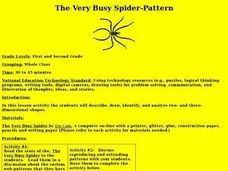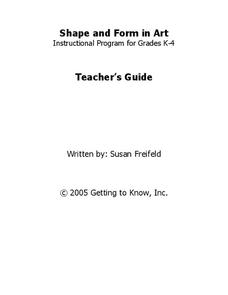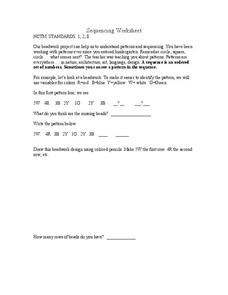Curated OER
Lines of Symmetry
A strong PowerPoint provides several examples of lines of symmetry found in nature. Each slide shows a different picture and asks the question, "Where are the lines of symmetry?" This resource would be good for reinforcing the concept of...
Curated OER
Why Do People Fall in Love?
Students discuss human behavior, sexual selection and the underlying genetic and evolutionary reasons for mate selection. The, in groups, they rate the attractiveness of certain individuals and measure facial features for symmetry.
Curated OER
The Geometry of Paul Goble's Artwork
Students examine the concepts of geometry used by Paul Goble in his book Adopted By The Eagles. After analyzing Mr. Goble's work they create an original piece featuring symmetry, pattern, repetition, and other principles of geometry....
Curated OER
Symmetry: Theory, Reality and Art!
Students explore the concept of geometric symmetry. In this geometric symmetry lesson, students walk around their school and take pictures of objects that demonstrate symmetry. Students use Microsoft Paint to draw the lines of symmetry...
Curated OER
Symmetry
Students make a design with pattern blocks and then pass them on to the rest of the class. They have to make them symmetrical and complete the design.
Curated OER
Geometry and Symmetry
Learners examine tessellations and their geometric properties. The lesson and discussions may be used to develop students' understanding of polygons and symmetry as well as their ability to analyze patterns.
Curated OER
Geo Jammin' By DeSign - Day 5, Lesson 25: Geo Jungle
Students search the school grounds for examples of symmetry in nature. They bring examples back to the classroom and write about them.
Curated OER
Reflecting a Rectangle Over a Diagonal
Use the handout as guided or independent practice in drawing a reflection of a rectangle over a line. Three rectangles are provided for practice in addition to a critical thinking question.
Mathematics Vision Project
Module 6: Congruence, Construction, and Proof
Trace the links between a variety of math concepts in this far-reaching unit. Ideas that seem very different on the outset (like the distance formula and rigid transformations) come together in very natural and logical ways. This...
Curated OER
Reflections and Equilateral Triangles
Your learners collaboratively find the lines of symmetry in an equilateral triangle using rigid transformations and symmetry. Through congruence proofs they show that they understand congruence in terms of rigid motions as they...
Illustrative Mathematics
Reflections and Isosceles Triangles
Geometers explore symmetries of isosceles triangles by using rigid transformations of the plane. They complete four tasks, including congruence proofs, which illustrate the relationship between congruence and rigid transformations. The...
Curated OER
Invertebrate Phyla
Students explore the invertebrate phyla. They discuss the characteristics of the invertebrate Phyla in the Kingdom Animal. Students classify organisms into Phyla based on their characteristics. They distinguish radial symmetry, bilateral...
Curated OER
Mathematics in Art?
Fifth graders view prints of M.C. Escher's work. They look at examples of geometric figures and polygons and discuss places they have seen them. Students create their own tessellations. They write a report about the process they used in...
Curated OER
Cut Outs: Shapes and Symbols
Students create collages based on Juan Quick-to-See Smith's "Ode to Chief Seattle." In this shapes, symbols and Native American lesson, students examine the "Ode to Chief Seattle" and Henri Matisse's cutout work. Students design their...
Curated OER
Geometry History Lesson
Tenth graders investigate the early history of geometry. In this geometry lesson, 10th graders investigate translations, rotations, and reflections. They also solve problems with line of symmetry and rotational symmetry while reviewing...
American Museum of Natural History
Draw a Monarch
Five steps walk scholars through the process of drawing a Monarch butterfly. Participants research the insect, make observations, trace, then color.
Curated OER
Geometrically Artistic/Artistically Geomtric
Students identify the two-dimensional geometric shapes Lowrey utilized in the painting Untitled. Students compare the two-dimensional shapes in terms of equivalent fractions, congruency, symmetry and asymmetry. Students create their own...
Curated OER
The Very Busy Spider-Pattern
Students explore two- and three-dimensional shapes. In this very busy spider lesson, students read the story and then create a spider web pattern of their own. The webs must use a symmetrical pattern. Additional activities...
Curated OER
Radial Design Mandala
Students design original radial art designs.For this radial design lesson, students use compasses and a nature inspired idea to create radial art. Students understand the use of symmetry, balance and design shapes in continual patterns....
Curated OER
Terrific Tessellations
Students explore tessellations that are found in nature and everyday objects. They observe the works of M.C. Escher. Students create their own tessellations using pencil and paper.
Curated OER
Comparing and Contrasting
Young scholars practice compare and contrast skills. In this science and language development lesson, students complete a T chart generating traits of a snail and a clam. Young scholars complete a related worksheet.
Getting to Know
Shape and Form in Art
Introduce youngsters to the important role shape and form play in art with this extensive collection of activities and projects. From teaching first graders how to create mandalas to engaging third and fourth graders in the design...
Curated OER
Sequencing Worksheet
In this patterns and sequencing activity, 9th graders complete 30 math problems that involve patterns and rules. Students must read information as they work through the math problems.
Curated OER
Spiders' Wheel
Students engage in a lesson which reinforces the concepts of clockwise and anti-clockwise rotation, while developing an understanding that angles are measured in degrees. They utilize a mathematics educational program to gain practice.


